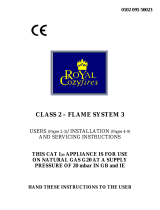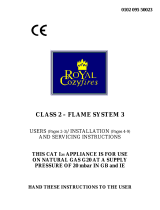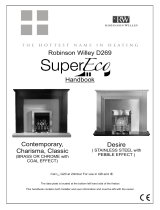1.7 FITTING TO FIREPLACES WITH EXISTING CHAIRBRICKS AND
CONVENTIONAL BRICKBUILT CHIMNEYS
This appliance is suitable for use in fireplaces fitted with an existing chairbrick
without the need for removal of the chairbrick, providing the minimum depth of the
fireplace exceeds 190mm. If the depth is less than 190mm then the spacer
(optional) must be used to give a minimum clearance from the rear of the fire to
the rear of the chairbrick of at least 90mm to allow sufficient space for the collec-
tion of debris which may fall down the chimney. The fireplace must be checked to
ensure that no part of the chairbrick is within 50mm of the flue outlet of the fire
when installed.
1.8 FITTING TO PRE-CAST FLUE INSTALLATIONS
When installing this appliance into pre-cast flues, always ensure that the
spigot restrictor baffle has been removed.
To install the fire box in to pre-cast flue starter blocks, there must be at least
120mm from the mounting face of the fire to the rear of the pre-cast flue
starter block to allow sufficient space for debris collection. It is important to
consider this depth when choosing a fire surround as the thickness of the fire
surround must be sufficient to give a total depth of at least 120 mm to the rear of
the starter block, otherwise there will be insufficient depth. To increase this depth
the fire surround may be packed away from the wall using suitable
non-combustible board, providing the installation is correctly sealed. If in doubt
about the suitability of the fire contact CFM Europe for advice before proceeding.
It is important to ensure that the pre-cast flue is in good condition and is free from
extruded mortar or sealant from between the flue blocks.
This appliance has been tested for use in a pre-cast flue block complying
with BS 1289. In accordance with BS 1289 Part 1, pre-cast flues built with
directly plastered faces (front or rear) are not correctly installed as to ensure
proper operation with any type of gas fire. In some instances of this flue
construction, temperature cracking of surface plaster may occur through no
fault of the appliance. An air gap or some form of insulation material should
be installed to prevent normal flue temperatures from damaging wall
surfaces.
1.9 FITTING TO PRE-FABRICATED TWIN WALL METAL FLUE BOXES
The appliance may be fitted to twin wall metal flue boxes conforming to the con-
structional requirements of BS 715, (for example the Selkirk LFE 125 box). The
box must have a minimum flue diameter of 125mm internal and minimum internal
dimensions of 160mm deep by 580mm high by 350mm wide. There are no maxi-
mum dimensional requirements for the box. The top face of the box must be
insulated with a minimum thickness of 50mm of non-combustible mineral wool
insulation or similar material. The flue box must stand on a non-combustible base
of minimum thickness 12mm.
8
























